斯派莎克教材_蒸汽输送系统
斯派法克说明书1
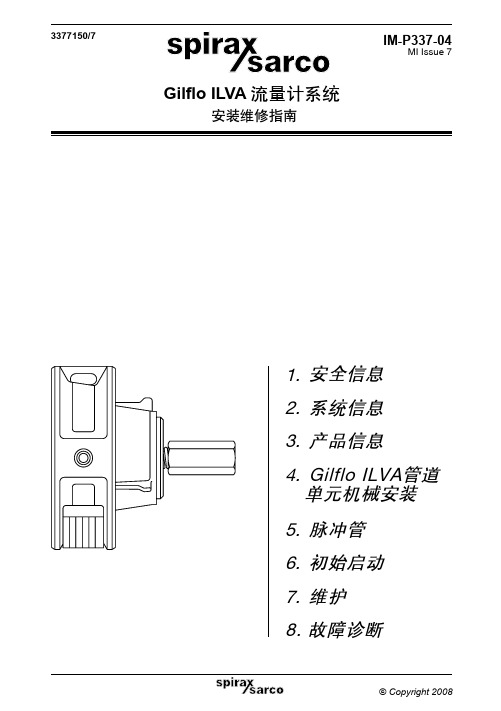
3.2 口径和管道连接
DN50, DN80, DN100, DN150 和 DN200. 可安装于以下法兰之间: EN 1092 PN16, PN25, 和 PN40. BS 10 表 H. ANSI B 16.5 class 150, 300 和600. 日本工业标准JIS 20. 韩国标准KS 20.
1.2 接近
在该设备上从事作业之前应确保通道安全。也可搭建工作平台,四周有适当的防护装置,若需 要可安排适当的升降起重装置。
1.3 照明
保证光线充足,特别是在细致、复杂的操作时。
1.4 管线中的危险流体或气体
要提前考虑管线内的流体,或者管线内可能有哪些流体。当心易燃物质,危害健康物质和高低 温物质。
1.7压力系统
确保系统压力被隔离,或完全排空。可以考虑双截止阀隔离,将关闭阀门锁上或贴上标签。千万 不要认为压力表归零就表示系统已完全泄压。
1.8温度
产品隔离后要冷却至室温,以防止烫伤。
1.9工具和备件
运行前确保手头有合适的工具和备件。只能使用真正的斯派莎克备件。
1.10防护服
要考虑操作人员或附近人员是否该配备防护服,以防止发生危险,如化学物质,高低温,辐射, 噪音,跌落物体,以及对眼睛和脸部的伤害。
102 bar g @ 20°C 450°C @ 40 bar g -50°C 0.6 bar g 450°C @ 40 bar g -29°C 30 cp 498 m bar 155 bar g
(2 248 psi g)
3.5 压降
最大流量时经过Gilflo ILVA管道件压差是500 m bar (200英寸水柱)。
I) 该设备设计适用于蒸汽压缩空气、水或冷凝水,均在组2压力设备规程中提到。该产品也可用 于压力设备指令中组1提到的丙烷或甲烷。如果考虑该产品用于其它流体,则需要与斯派莎克公 司联系,确认考虑应用该产品时的可靠性。 II)应检查选用的材质是否合适,压力和温度及它们的最大和最小值。如果该产品的最大极限值 低于将要安装的系统,或由于产品不正常导致发生超压或超温,确保系统中包括安全设施,以 防出现超过极限值的状况。 III)确定正确的安装位置和介质流向。 IV)斯派莎克的产品不能承受安装系统中任何可能产生的外部应力作用,考虑这些应力作用是安 装者的责任。同时也应采取适当的预防措施来减小这些应力作用。 V)在安装前拆去所有接口的保护盖。
蒸汽输送管道的水击及其防范
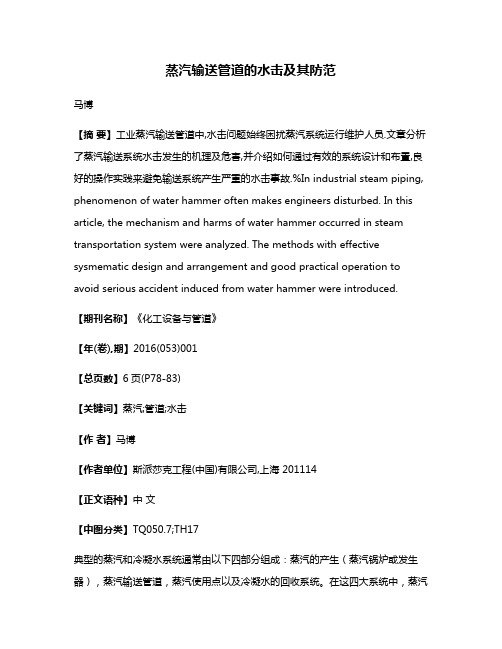
蒸汽输送管道的水击及其防范马博【摘要】工业蒸汽输送管道中,水击问题始终困扰蒸汽系统运行维护人员.文章分析了蒸汽输送系统水击发生的机理及危害,并介绍如何通过有效的系统设计和布置,良好的操作实践来避免输送系统产生严重的水击事故.%In industrial steam piping, phenomenon of water hammer often makes engineers disturbed. In this article, the mechanism and harms of water hammer occurred in steam transportation system were analyzed. The methods with effective sysmematic design and arrangement and good practical operation to avoid serious accident induced from water hammer were introduced.【期刊名称】《化工设备与管道》【年(卷),期】2016(053)001【总页数】6页(P78-83)【关键词】蒸汽;管道;水击【作者】马博【作者单位】斯派莎克工程(中国)有限公司,上海 201114【正文语种】中文【中图分类】TQ050.7;TH17典型的蒸汽和冷凝水系统通常由以下四部分组成:蒸汽的产生(蒸汽锅炉或发生器),蒸汽输送管道,蒸汽使用点以及冷凝水的回收系统。
在这四大系统中,蒸汽输送管道起到连接蒸汽产生的源头和使用点,输送蒸汽的作用,根据系统规模的大小及距离的长短,输送系统的规模也不尽相同。
通常输送管道的水击发生在系统刚刚投用之初,用汽负荷由低到高突然变化[1],以及系统刚刚停运等阶段,每个过程发生的水击现象也不尽相同。
例如在系统投运以及负荷变大时,管道多阶段性地发出“咚咚”的声响;而停运后,蒸汽管道多阶段性的发出如金属敲击般的尖锐声响。
斯派莎克教材疏水阀的原理及应用

双金属片
路漫漫其修远兮, 吾将上下而求索
双金属疏水阀的工作曲线
温度 (oC)
饱和蒸汽曲线
疏水阀工作曲线
路漫漫其修远兮, 吾将上下而求索
压 力 (bar g)
工作原理
起 动 时, 阀 处 于 常 开 位 置
冷态的凝结水和空气可迅 速排出
随 着 热 的 凝 结 水 流 过, 双 金 属 片 被 加 热 动 作, 开 始 关 闭 阀 门。
冷 凝 水 到 达 疏 水 阀, 浮 球 升 起, 阀 门 打 开 。热态冷凝水使排气 阀 关 闭。 冷 凝 水 以 饱 和 温 度 排 出。
蒸 汽 到 达 疏 水 阀, 浮 球 下 沉, 阀 门 关 闭。
路漫漫其修远兮, 吾将上下而求索
浮球式蒸汽疏水阀的特点
优 点: • 在 饱 和 温 度 下 连 续 排 放 冷 凝 水, 排 量 大 • 能 适 应 高 低 负 荷 的 变 化, 不 受 压 力 变 化 的 影 响 • 装 有 自 动 排 气 阀 的 型 号, 排 气 性 能 良 好 • 使 用 内 置 破 蒸 汽 汽 锁 装 置 的 型 号, 是 有 蒸 汽 汽 锁 现 象 应 用
的 唯 一 选 择。
消毒器
双金属式蒸汽疏水阀
最 大 压 力 45 bar g
路漫漫其修远兮, 吾将上下而求索
双金属片
冷
热
加热
路漫漫其修远兮, 吾将上下而求索
斯派莎克双金属疏水阀
锻造的阀体 和阀盖
爪型双金属片设 计, 保 证 疏 水 阀 的 工 作 性 能。
内置不锈钢滤网
阀芯设计 开启迅速
路漫漫其修远兮, 吾将上下而求索
浮球式蒸汽疏水阀
旋转的阀盖可 适合不同方向
斯派莎克减压阀、汽水分离器内部结构、功能
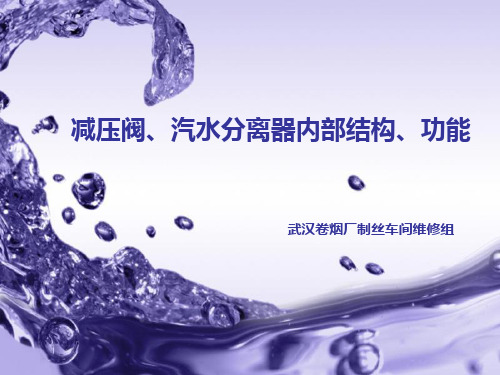
Powerpoint Templates
Page 11Powerpoint Fra bibliotekemplates
Page 12
二.减压阀的使用注意事项
使用建议:
• • • • 减压阀丌能选型过大,否则容易冲蚀和引起“振荡” 减压阀通常比上游的蒸汽管道至少小一号管径 减压阀应避免管道的垃圾和水分的侵害(安装过滤器和汽水分离器) 上游和下游管道应根据流量及压力正确选择
Powerpoint Templates
Page 2
蒸汽工程基础知识
原则:高压输送,低压使用 高压输送的优点:
蒸汽管道口径小,热损失小 蒸汽管道费用低,支撑费用少,人工费用低 管道的隔热费用低 通过减压阀在实用点可以获得更加干燥的蒸汽 锅炉操作哎高压更容易达到最佳运行状态,效率更高 锅炉的蓄热能力增加,容易处理负载的变化,减少汽水共腾和携带 的可能性
二.下游压力过低
压力设定丌正确 减压阀排量丌够 阀门丌能打开
三.下游压力波动大
负载变化大 选型过大
正常的控制偏差 选导阀隔膜或气动减压阀 选型参数不实际偏差大 按实际参数选型
Powerpoint Templates
Page 10
B.导阀隔膜式减压阀原理
启动前导阀弹簧处于自由状态时, 主阀和导阀处于关闭状态。 导阀有弹簧力作用打开,蒸汽经由 导阀进入主隔膜室,一部分蒸汽则 经由控制孔流出,当导阀流入的蒸 汽大于由控制孔流出的蒸汽,主隔 膜阀中的控制压力增大,打开主阀。 随着蒸汽流过主阀,下游压力的增 量经由感应管反馈,作用在导阀隔 膜下,平衡隔膜上部的弹簧压力, 使导阀组建关闭节流,维持主隔膜 中的压力,控制主阀开度输送适量 的蒸汽。调节导阀隔膜上的弹簧即 可改变下游压力。
斯派莎克教材_疏水阀的原理及应用

碟片将疏水阀关 闭
碟片上方的压力 作用将 再 次 被进口压力顶起
循环开始
蒸汽疏水阀 39
斯派莎克工程(中国)有限公司
热动力型蒸汽疏水阀的特点
优 点:
• 阀 本 体 结 构 结 实、 简 单、 重 量 轻, 使 用 寿 命 长, 安 装 费 用 低。 • 操 作 压 力 范 围 大, 不 需 因 压 力 的 变 化 而 调 整 或 更 换 阀 口 尺 寸。 • 抗 水 锤、 振 动、 腐 蚀, 本 体 不 为 冷 冻 破 坏, 可 适 用 于 过 热 蒸 汽, 可 在 任 何 方 位 上 操 作。 • 唯 一 的 活 动 部 件- 不 锈 钢 碟 片, 保 证 操 作 可 靠, 减 少 维 修, 同 时 该 碟 片可 具 止 回 阀 作 用。
不能过大否则在正常工作情况下泄漏蒸汽负载情况下泄漏蒸汽漏蒸汽必须在进口安装止回暴露在过冷的环境中会冻结损坏必须加以保温型应用轮胎压热动力蒸汽疏水120bar热动力蒸汽疏水气锁碟片三孔冷凝水出口过滤器涂镍表面起动时进口压力将碟片顶凝结水及空气迅速排热动力疏水阀工作原理疏水阀时产生高速的二次蒸在碟片下形成进入碟片上方碟片将疏水压力作用在碟片被进口压力顶起阀本体结构结实简单重量轻使用寿命长安装费用低
蒸汽疏水阀 4 斯派莎克工程(中国)有限公司
压力平衡式热静力疏水阀
最 大 压 力 为 32 bar
蒸汽疏水阀 5 斯派莎克工程(中国)有限公司
压力平衡式热静力疏水阀
三种不同凝结水 排放温度的液囊 可供选择
防腐蚀的 316L 不 锈 钢 液 囊 无石棉垫片 内置防冲蚀 导向挡板 可选内置 过滤网型号
• 附 有 空 气 排 除 的 碟 片, 可 防 止 空 气 阻 塞。
• 该 疏 水 阀 在 开 关 时 发 出“ 喀 嚓”声,可 帮 助 判 断 疏 水 阀 是 否 正 常 工 作 。 缺 点: • 过 低 的 进 口 压 力 和 过 高 的 背 压 均 使 疏 水 阀 无 法 工 作。 • 不 含 防 气 锁 碟 片的 型 号, 在 起 机 时 易 发 生 气 阻。 • 暴 露 在 低 温 环 境 中, 会 造 成 阀 开 关 频 繁, 降 低 寿 命, 必 须 加 隔 热 罩。
斯派莎克蒸汽疏水阀 产品应用指南说明书
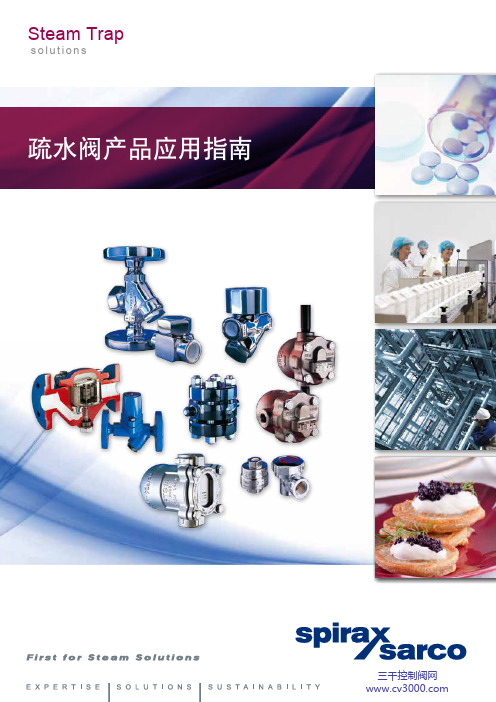
疏水阀产品应用指南Steam Traps o l u t i o n s● 我们的子公司、办事处及授权经销商遍布全世界100多个国家和地区●35个培训中心与您分享知识产品可持续发展(Sustainability)斯派莎克将致力于为客户管理好您的蒸汽系统,提供全面的能源审计,或是为您的质量、业务或生产方面的问题提供全套产品和服务,满足您的可持续发展目标。
专业技术(Expertise)斯派莎克的专业知识和技能源于100多年来的全球蒸汽工程应用经验。
这些知识和技能通过全球的35个培训中心,各种培训课程和技术出版物向客户传播。
我们所运用的专业技术是可以为客户提供的最基本而最宝贵的部分,也正是这些因素让我们与众不同,成为行业中的领先者。
斯派莎克是专业致力于推广有效的使用和控制蒸汽、热水和压缩空气等多种工业流体的节能公司。
斯派莎克在全球范围内使用专业知识和技能为广大蒸汽用户提供解决方案,从而显著提高其设备性能和系统效率,节约能源,满足您的可持续发展目标。
斯派莎克公司历史可追溯至1888年,1937年建址于英国,1959年斯派莎克集团公司在伦敦股票市场上市,每年均有骄人的业绩报告。
斯派莎克在英国、法国、德国、美国、阿根廷、巴西、意大利等国家均有生产基地,质量管理通过ISO9000体系认证,产品通过PED 认证。
解决方案(Solutions)斯派莎克作为蒸汽及热能整体解决方案提供商,我们将根据您工艺应用的具体需求,提供具有针对性的产品、系统与服务,对蒸汽和相关工艺产生的废弃物中热能的控制、再利用、回收和储存做出改造,从而达到降低您的成本,改进工艺可靠性及能效水平,帮您提高生产效率与利润。
●1000位销售工程师竭诚为您服务●100,000位长期客户遍布全球/cn斯派莎克蒸汽疏水阀斯派莎克的历史可以追溯到1888年,世界上第一台疏水阀就是由斯派莎克生产的。
经过100多年的发展,斯派莎克已经能够提供浮球型、热动力型、热静力型、双金属式和倒吊桶式等各种形式的高品质蒸汽疏水阀,至今已广泛应用在各种设备上,得到客户高度好评。
蒸汽和冷凝水系统手册-第11章蒸汽疏水

11.1.2
蒸汽和冷凝水系统手册
第11章
蒸汽疏水
导言—蒸汽系统为什么要进行疏水
章节11.1
设备性能 考虑完排除空气和冷凝水的基本要求后,我们再来关注一下“设备性能”。简单来讲,除非是特殊设 计而允许积水,一个热交换器要工作性能良好,蒸汽空间内的蒸气必须要干燥、干净,这些都起决于疏水 阀的形式,比如,热静力疏水阀只有在冷凝水冷却到低于饱和温度的某一温度下才会排水。如果冷凝水滞 留在蒸汽空间内,将会减小换热面积,降低换热器性能。在尽可能低的温度点排除冷凝水似乎很好,但大 多数的应用一般都需要在饱和温度点排除冷凝水。这时需要不同于热静力工作原理的疏水阀,通常使用机 械式的或热动力式的疏水阀。 在选择一个特定的疏水阀时,我们需要考虑制程的需要,这通常会决定疏水阀的形式。制程中的蒸汽 和凝水系统的连接方式可能也会影响疏水阀的形式,使之能够在既定环境下高效工作。一旦选定疏水阀的 形式,我们就需要确定其口径,由系统条件和如下参数决定: 蒸汽和冷凝水的最高压力。 蒸汽和冷凝水的工作压力。 温度和流量。 制程中是否有温度控制。 这些参数将在接下来的章节中讨论。 可靠性 经验表明可靠性即为良好的阻汽排水性能,也就是说无需特别关注,就能工作良好。 疏水阀变得不可靠通常有如下原因: 腐蚀 - 由于冷凝水的原因,这可以通过使用特殊的结构材料和改善的给水条件得到解决。 水锤 - 通常是由于疏水阀后的提升,这有时在设计阶段被忽略,经常会引起对其它可靠疏水阀的不 必要的破坏。 污垢 - 在水处理过程中的一些化学物质被蒸汽带出锅炉后积聚,或是管道碎屑影响疏水阀的正常工作。 疏水阀的基本作用就是合乎时宜的排除冷凝水和空气,这就需要对疏水阀的工作原理有清楚的认识。 闪蒸蒸汽 闪蒸蒸汽是由于热的冷凝水由高压系统进入到低压系统中自然闪蒸产生的,这可能会使观测者对疏水 阀的工作状况产生误解。 首先考虑在蒸汽饱和温度和压力下形成的冷凝水的焓 值(查蒸汽表),例如,在7 bar g的压力下, 170.5℃时,冷凝水的焓 值是721kJ/kg,如果该冷凝水排放到大气中,只能以100℃水的形式存在,包含 419 kJ/kg的热焓。而剩下的热量721 - 419即302kJ/kg将蒸发一定比例的水,在大气压下产生一定数量的 蒸汽。 在低压下形成的蒸汽通常被称为闪蒸蒸汽,闪蒸蒸汽的数量可用如下方法计算: 闪蒸蒸汽量 = = = 过剩热量 kJ/kg 低压蒸汽的蒸发焓值 302.0 kJ/kg 2257.0 kJ/kg 0.134 kg/kg 或 13.4% 如果疏水阀排放的冷凝水量为500kg/h,从7 bar g排放至大气中,产生的闪蒸蒸气将为500x0.134 = 67kg/h。相当于38kW的热量损失。 这说明,相当一部分的能量在蒸汽 - 冷凝水系统的热平衡中损失掉了。如果它能够被收集和利用,则 可以大大增加系统的效率。
蒸汽输送系统PPT
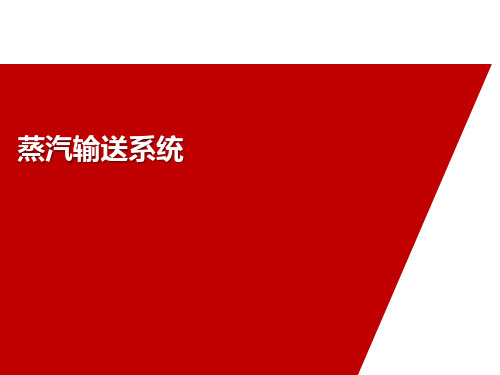
蒸汽输送系统
1 蒸汽产生系统
2 蒸汽输送与分配
目 3 蒸汽疏水系统及附属设备 录
4 蒸汽压力控制
5 凝结水回收
系统
锅炉
蒸汽
凝结水 蒸汽输送系统
锅炉
疏水系统
凝结水回收系统
除氧器
水处理
PT
单元
凝结水处理系统
蒸汽就是把锅炉中的水,通过加热而产生的一种透明气体。在一定压力下,必须用足够的 能量才能把水温升到沸点。之后再增加的能量只能把水转化为蒸汽,并不能升高水温。
蒸汽系统可能有产生(有锅炉或或无锅炉而由热电厂供汽)系统、管网输送、用汽设备 疏水、凝结水回收及利用(水质合格不需处理)系统。 如楼宇酒店、小型企业、食品行业等均为此类系统。
一、蒸汽产生系统
➢低 压:<1.57MPa; ➢次高压: 3.83~6.73MPa; ➢超高压:13.8~16.7MPa; ➢临界点:22.1MPa/374℃
二、蒸汽输送与分配
蒸汽管道内水击的形成
蒸汽管道内水击的形成:水随着蒸汽一起高速流动,蒸汽设计流速应该在30m/s,水在管道 内的设计流速一般在1 m/s。当水与蒸汽一起按照蒸汽流速流动时,由于水的比容重量远远高 于蒸汽,其动量会很大,对于更改其流动方向的弯头、三通、阀门附件等处会造成很大的冲 击,即水击。一般在开车暖管阶段容易遇到水击听到撞击声音,升温速度快就很容易形成。
- 1、下载文档前请自行甄别文档内容的完整性,平台不提供额外的编辑、内容补充、找答案等附加服务。
- 2、"仅部分预览"的文档,不可在线预览部分如存在完整性等问题,可反馈申请退款(可完整预览的文档不适用该条件!)。
- 3、如文档侵犯您的权益,请联系客服反馈,我们会尽快为您处理(人工客服工作时间:9:00-18:30)。
9
9.5 15.1 19.7 28.1 38.1 49.4 71 105 139 164 216 272 320 436
9.3 11.3 14.1 16.5 20.6 24.5 31.5 39 46.5 51.5 60 64 72 88
10
9.9 15.7 20.4 29.2 39.6 51.3 77 109 144 171 224 282 332 463
• 蒸汽使用点压力下降 • 没有足够的蒸汽量 • 容易产生水锤和冲蚀
蒸 汽 管 道 口 径 选 型 图 (kg/h)
Pressure Velocity
bar g
m/s
15
15.8
15
9
0.4
25
14
40
23
15
10
0.7
25
17
40
28
15
12
1
25
20
40
32
15
18
2
25
29
40
47
15
23
3
2778
782
2000
2782
799
1986
2785
815
1973
2788
830
1960
2790
845
1947
2792
Volume Dry Sat.
m3/kg 1.673 0.881 0.603 0.461 0.374 0.315 0.272 0.24 0.215 0.194 0.177 0.163 0.151 0.141 0.132
如使用燃油,每公斤燃油的热量为42,000kJ, 锅炉效率为 80%, 则需要燃油: 5,271,000,000 / ( 42000 x 0.8) =156,875公斤
总的燃油费用为 3 x 156875=470,625 元
回收冷凝水的节约
( 二) 水 的 费 用
每年节约水为 5000 x 0.7 x 20 x 300/1000 = 21000吨 如 果 每 吨 水 费 用 为 1.5 元
362 603 965 433 722 1155 503 839 1342 735 1226 1961 962 1603 2565 1186 1976 3162 1408 2347 3755 1631 2718 4348 1848 3080 4928
125 128.2 569 948 1517 681 1135 1815 791 1319 2110 1156 1927 3083 1512 2520 4032 1864 3106 4970 2213 3688 5901 2563 4271 6834 2904 4841 7745
蒸汽排空气阀
Steam Main 热动力疏水阀
空气
起 机 负 载/ 运 行 负 载
(kg 每 50 m 主 蒸 汽 管)
Steam Pressure
Steam Main Size (mm)
(bar g) 50 65 80 100 125 150 200 250 300 350 400 450 500 600
86
118
194
277
427
144
196
323
461
712
230
314
517
737
1139
113
154
254
362
559
188
256
423
603
931
301
410
676
964
1490
139
190
313
446
689
232
316
521
743
1148
371
506
833
1189 1836
165
225
371
529
9.8 11.9 14.6 16.9 21.3 25 33 41 49 54 62 67 75 90
11 10.4 16.5 21.6 30.7 41.7 54.1 81.1 115 152 180 236 298 350 488
10.9 13 15.7 17.7 22.5 26 36 45 53 59 67 73 81 97
斜体表示运行负载 环 境 温 度 为 200C, 保 温 效 率 为 80%
光管的热损失
Temp. Difference Steam to Air
Pipe Size (mm)
15
20
25
32
40
50
65
80
100 150
oC
W/m
56
54
65
79
103 108 132 155 188 233 324
80
35.04 40.9
52.5
62.7 77.92
43
58
95
136
210
71
97
159
227
350
113
154
254
363
561
51
69
114
163
251
85
115
190
271
419
136
185
304
434
671
59
81
133
189
292
99
134
221
315
487
158
215
354
505
779
• 在 以 下 点 进 行 疏 水: 在 蒸 汽 管 道 的 每 一 低 点; 每 隔 30-50 米 之 间; 在 主 管 和 分 支 管 道 的 末 端; 在 可 能 关 闭 的 阀 门 以 前
• 在 流 动 方 向, 管 道 应 该 有 一 定 的 坡 度 • 排水点的集水罐应正确选型 • 使 用 偏 心 缩 小 管, 不 要 安 装 同 心 缩 小 管 • 蒸汽支管应该从主管的上方取蒸汽 • 过滤器应安装在侧面 4 所有蒸汽主管应有效保温
25
38
40
61
15
28
4
25
47
40
75
15
34
5
25
56
40
90
15
39
6
25
65
40
104
15
44
7
25
74
40
118
20 20.93
15 25 40 18 30 48 21 35 56 31 51 82 40 67 107 50 83 132 59 98 157 68 114 182 77 129 206
温 度 (oC)
温 度- 压 力 曲 线
250
200
150
100
50
0 0 1 2 3 4 5 6 7 8 9 10 11 12 13 14 压 力 (bar g)
饱 和 蒸 汽 比容 和 压 力 之 间 的 关 系
(m3/kg)
1.8
1.6
1.4
1.2
1
0.8
0.6
0.4
0.2
0
0
1
2
3
4
5
6
高压输送蒸汽
高 压 输 送 的 优 点:
• 蒸 汽 管 道 口 径 小, 热 损 失 少. • 蒸 汽 管 道 费 用 低, 支 撑 费 用 少, 人 工 费 用 降 低. • 管 道 的 隔 热 费 用 低. • 通 过 减 压 在 使 用 点 可 以 获 得 更 加 干 燥 的 蒸 汽. • 锅 炉 操 作 在 高 压 更 容 易 达 到 最 佳 运 行 状 态, 运 行 效 率 高. • 锅 炉 的 蓄 热 能 力 增 加, 容 易 处 理 负 载 的 变 化, 减 少 汽 水 共
817
276
375
619
882
1362
441
601
990
1411 2180
191
261
430
613
947
319
435
716
1022 1578
511
696
1146 1635 2525
217
296
487
695
1073
362
493
812
1158 1788
579
788
1299 1853 2861
100 102.26
10 bar
温 度:
180C
蒸 汽 输 送 质 量:
3000 kg/h
管 道 口 径:
DN100
管 道 长 度:
100 米
环 境 温 度:
20 C
热 损 失:
1016 W/m
蒸 汽 潜 热:
2000 kJ/kg,
蒸 汽 冷 凝 率:
1.016 X 3600/2000 = 1.83 Kg/m. h
100 米 常 的 冷 凝 总 量:
腾 和 携 带 的 可 能 性.
低压使用蒸汽的优点
压力降低可以提供蒸汽中更大比例的潜热 减少冷凝水所含热量,减少二次蒸汽 经过减压后蒸汽具有更高的干燥度
减压站
如 何 确 定 管 道 口 径?
两 种 基 本 方 法: • 流速法 • 压降法
管道选型
• 费用增加 • 热损失增加 • 形成的冷凝水增加
蒸汽流量计 / wenku1
蒸汽输送分配系统
典型的蒸汽流程
蒸汽 蒸汽
煮锅
煮锅 冷凝水
制程 设备
空间 加热 系统
大槽
蒸汽 锅炉
补给水 给水泵
